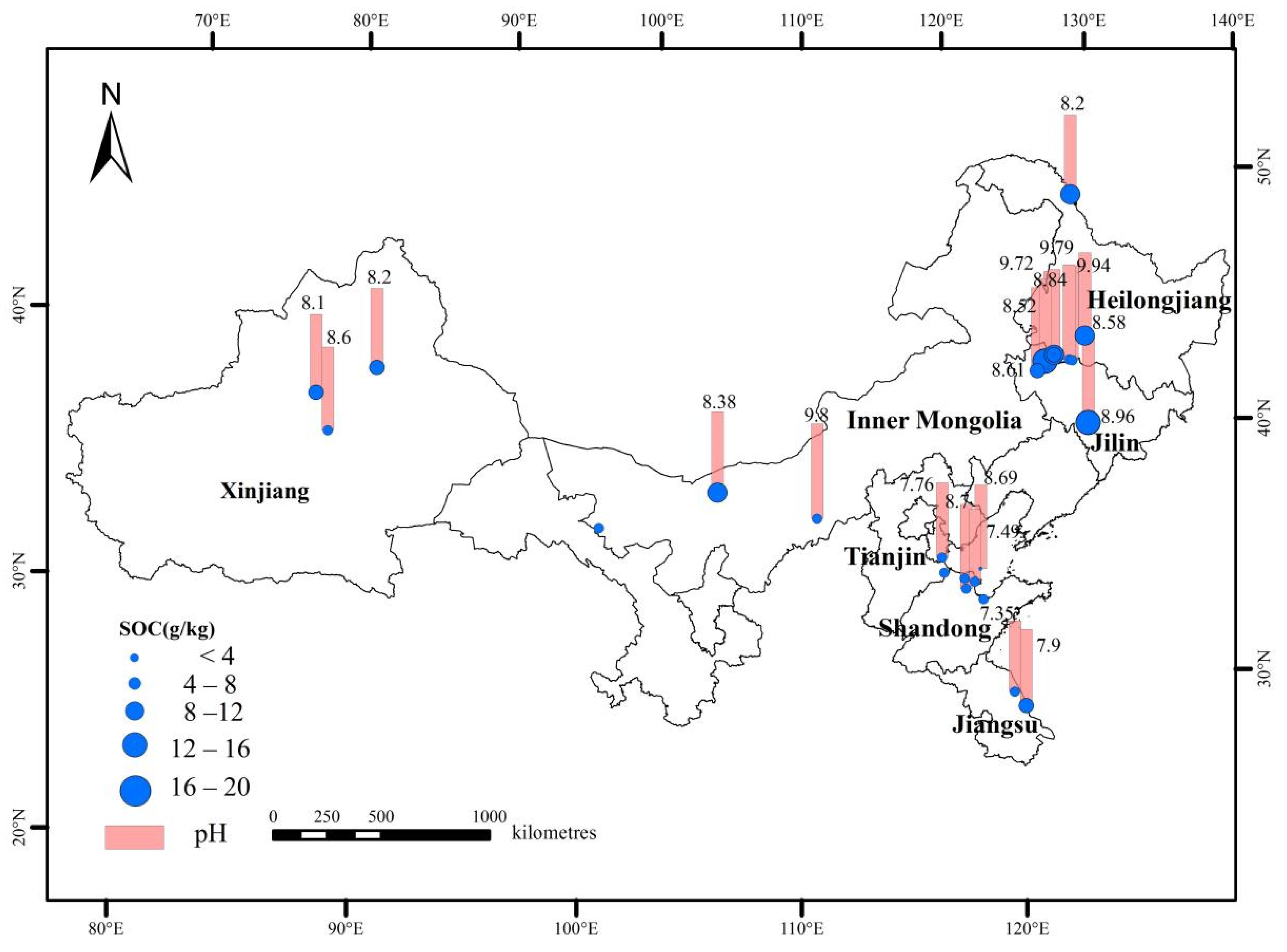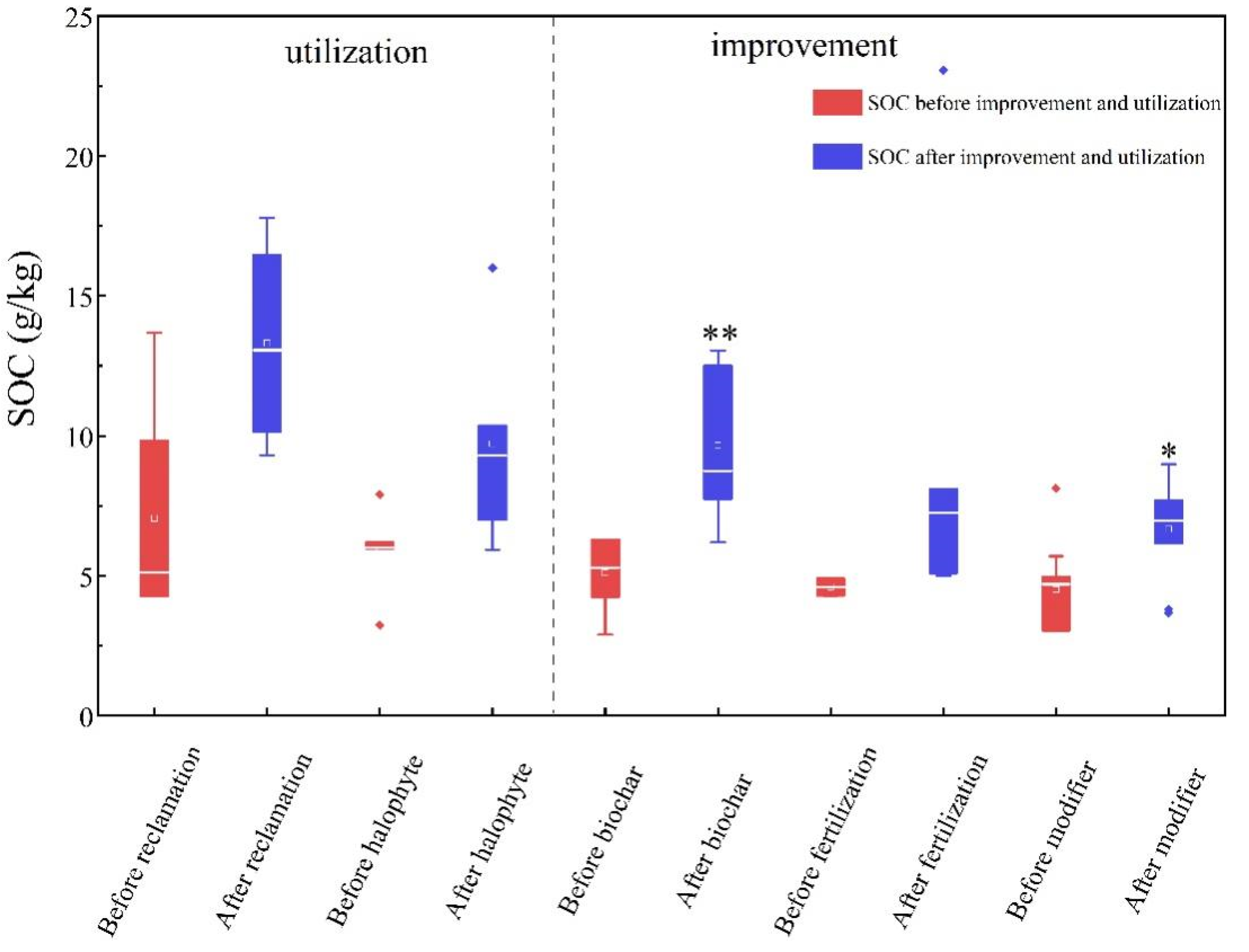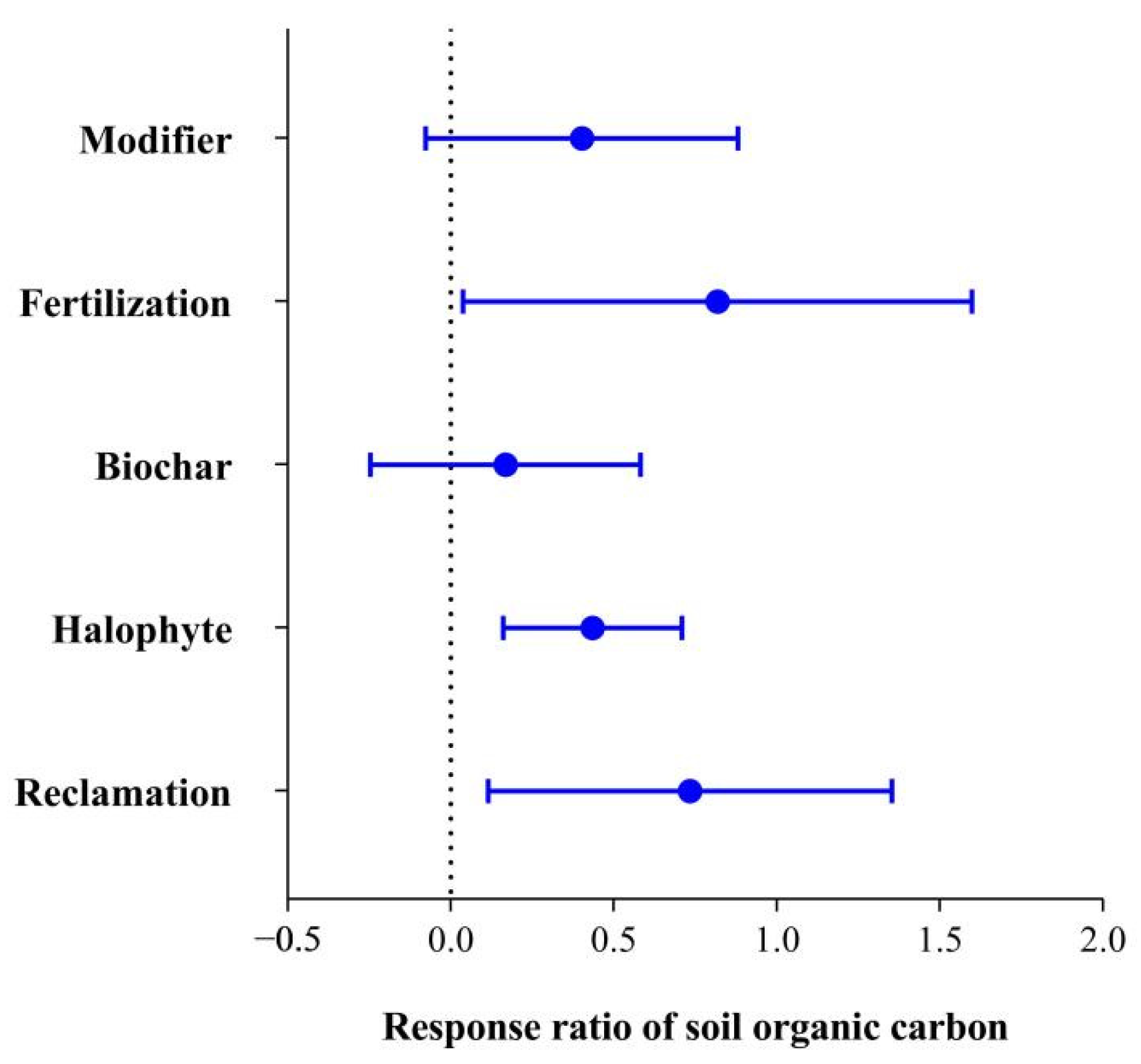Meta-Analysis of the Effect of Saline-Alkali Land Improvement and Utilization on Soil Organic Carbon
Abstract
1. Introduction
2. Materials and Methods
2.1. Data Sources
2.2. Data Extraction
2.3. Statistical Analysis
3. Results
3.1. Regional Distribution of Soil Organic Carbon in Saline-Alkali Soil in China
3.2. Response Characteristics of SOC to Improvement and Utilization
3.3. The Relationship between SOC and Other Physicochemical Properties in Saline-Alkali Soil
4. Discussion
4.1. The Relationship between the Type and Content of Saline Alkali and SOC
4.2. Effect of Saline-Alkali Land Improvement on SOC
4.3. Changes of Physical and Chemical Properties of Soil after Saline-Alkali Land Improvement
5. Conclusions
Author Contributions
Funding
Institutional Review Board Statement
Informed Consent Statement
Data Availability Statement
Acknowledgments
Conflicts of Interest
References
- Sun, X.H.; Yue, Z.H. Overview of application of restoration ecology technology in saline alkali grassland restoration. Biol. Teach. 2018, 43, 6–8. [Google Scholar]
- Li, X.G.; Guo, K.; Feng, X.H. Study on carbon storage of soil vegetation system under different land use modes in coastal saline area. Chin. J. Ecol. Agric. 2017, 25, 1580–1590. [Google Scholar]
- Li, B.; Wang, Z.C.; Sun, Z.G.; Chen, Y.; Yang, F. Study on sustainable utilization of saline alkali land resources in China. Agric. Res. Arid. Areas 2005, 2, 154–158. [Google Scholar]
- Zhang, J.F.; Zhang, X.D.; Zhou, J.X.; Liu, G.H.; Li, D.X. World saline alkali land resources and basic measures for their improvement and utilization. Res. Water Soil Conserv. 2005, 6, 32–34. [Google Scholar]
- Ma, C.; Ma, L.Y.; Liu, T.X. Research progress on improvement and utilization technology of saline alkali land. World For. Res. 2010, 23, 28–32. [Google Scholar]
- Xu, C.L.; Dong, Y.C.; Lu, J.L. Research progress on soil improvement and resource utilization of coastal saline alkali land in China. World For. Res. 2020, 33, 68–73. [Google Scholar]
- Hu, M.F.; Tian, C.Y.; Zhao, Z.Y. Research progress on the causes and improvement measures of saline alkali land in Xinjiang. J. Northwest Agric. For. Univ. 2012, 40, 111–117. [Google Scholar]
- Zhang, H.; Fan, W.H.; Tian, J. Effect of improver application on water stable aggregates and organic carbon components of reclaimed soil in mining area. Soil Bull. 2022, 53, 392–402. [Google Scholar]
- Cui, Q.; Xia, J.; Yang, H. Biochar and effective microorganisms promote Sesbania cannabina growth and soil quality in the coastal saline-alkali soil of the Yellow River Delta, China. Sci. Total Environ. 2021, 756, 143801. [Google Scholar] [CrossRef]
- He, K.; He, G.; Wang, C. Biochar amendment ameliorates soil properties and promotes Miscanthus growth in a coastal saline-alkali soil. Appl. Soil Ecol. 2020, 155, 103674. [Google Scholar] [CrossRef]
- Pribyl, D.W. A critical review of the conventional SOC to SOM conversion factor. Geoderma 2010, 156, 75–83. [Google Scholar] [CrossRef]
- Ren, Y.; Lü, Y.; Fu, B. Biodiversity and Ecosystem Functional Enhancement by Forest Restoration: A Meta-analysis in China. Land Degrad. Dev. 2017, 28, 2062–2073. [Google Scholar] [CrossRef]
- Liu, M.; Wang, Z.C.; Yang, F. Application progress of biochar in saline alkali land improvement. J. Soil Water Conserv. 2021, 35, 1–8. [Google Scholar]
- Zhao, Y.; Wang, L.; Zhao, H.L. Research status and prospect of coastal saline alkali land improvement. Chin. J. Agron. 2022, 38, 67–74. [Google Scholar]
- Xu, X.H.; Liu, S.; Zhao, Y.J. The influence of different environmental factors on the distribution of soda saline alkali land in the west of Jilin Province. Water Soil Conserv. Bull. 2018, 38, 89–95. [Google Scholar]
- Chen, W.F.; Zhang, W.M.; Meng, J. Research progress and prospect of agricultural biochar. China Agric. Sci. 2013, 46, 3324–3333. [Google Scholar]
- Chen, X.; Diao, H.; Wang, S. Plant community mediated methane uptake in response to increasing nitrogen addition level in a saline-alkaline grassland by rhizospheric effects. Geoderma 2023, 429, 116235. [Google Scholar] [CrossRef]
- Gu, Y.; Wang, X.; Yang, T. Chemical structure predicts the effect of plant-derived low-molecular weight compounds on soil microbiome structure and pathogen suppression. Funct. Ecol. 2020, 34, 2158–2169. [Google Scholar] [CrossRef]
- Schimel, J.P.; Schaeffer, S.M. Microbial control over carbon cycling in soil. Front. Microbiol. 2012, 3, 348. [Google Scholar] [CrossRef]
- Luo, G.; Li, L.; Friman, V. Organic amendments increase crop yields by improving microbe-mediated soil functioning of agroecosystems: A meta-analysis. Soil Biol. Biochem. 2018, 124, 105–115. [Google Scholar] [CrossRef]
- Liang, J.; Shi, W. Cotton/halophytes intercropping decreases salt accumulation and improves soil physicochemical properties and crop productivity in saline-alkali soils under mulched drip irrigation: A three-year field experiment. Field Crops Res. 2021, 262, 108027. [Google Scholar] [CrossRef]
- Zakery-Asl, M.A.; Bolandnazar, S.; Oustan, S. Effect of salinity and nitrogen on growth, sodium, potassium accumulation, and osmotic adjustment of halophyte Suaeda aegyptiaca (Hasselq.). Arch. Acker-Pflanzenbau Bodenkd. 2014, 60, 785–792. [Google Scholar]
- Ashraf, M.Y.; Ashraf, M.; Mahmood, K.; Akhter, J.; Hussain, F.; Arshad, M. Phytoremediation of saline soils for sustainable agricultural productivity. In Plant Adaptation and Phytoremediation; Springer: Dordrecht, The Netherlands, 2010; pp. 335–355. [Google Scholar]




| Study Area | Latitude Longitude | Land Use Type | Soil Type | pH | Average Organic Carbon Content (g/kg) |
|---|---|---|---|---|---|
| Shanghai | 121°54′ E, 31°34′ N | Degraded grassland | Chestnut soil | 8.1 | 4.96 |
| Xinjiang | 87°56′ E, 44°17′ N | Desert | Chestnut soil | 8.2 | 10.64 |
| Xinjiang | 87°56′ E, 44°17′ N′ | Desert | Chestnut soil | 8.2 | 9.16 |
| Jilin | 124°22′ E, 45°46′ N | Farmland | Soda saline-alkali soil | 9.2 | 13.67 |
| Jilin | 123°221′ E, 44°461′ N | Farmland | Chestnut soil | 9.1 | 15.5 |
| Xinjiang | 85°08′ E, 42°51′ N | Farmland | Grey desert soil | 8.1 | 10.09 |
| Jilin | 125°18′ E, 45°28′ N | Farmland | Chestnut soil | 9.72 | 4.29 |
| Jilin | 124°68′ E, 44°91′ N | Degraded grassland | Soda saline-alkali soil | 9.79 | 4.96 |
| Gansu | 100°30′ E, 39°42′ N | Farmland | Grey desert soil | 8.9 | 6.01 |
| Inner Mongolia | 106°20′ E, 41°18′ N | Farmland | Chestnut soil | 8.2 | 13.27 |
| Jilin | 124°1′ E, 45°19′ N | bare land | Soda saline-alkali soil | 9.94 | 3.05 |
| Jiangsu | 120°22′ E, 33°32′ N | Farmland | Chestnut soil | 8.5 | 12 |
| Jilin | 126°11′ E, 46°18′ N | Farmland | Chestnut soil | 9.41 | 14.74 |
| Jilin | 124°22′ E, 45°46′ N | Farmland | Chestnut soil | 9.45 | 9.92 |
| Jilin | 124°1′ E, 45°19′ N | Farmland | Soda saline-alkali soil | 9.94 | 1.68 |
| Shandong | 118°31′ E, 37°54′ N | Farmland | Chestnut soil | 8.3 | 6 |
| Xinjiang | 86°12′ E, 41°36′ N | Farmland | Chestnut soil | 8.5 | 6.2 |
| Shandong | 119°20′ E, 37°04′ N | Coastal wetland | Chestnut soil | 8.9 | 6 |
| Shandong | 118°59′ E, 37°45′ N | Coastal wetland | Chestnut soil | 7.49 | 5.35 |
| Shandong | 37° 03′ E, 119°39′ N | bare land | Chestnut soil | 8.8 | 2.9 |
| Jilin | 123°51′ E, 45°35′ N | Farmland | Chestnut soil | 9.63 | 17.8 |
| Jilin | 124°1′ E, 45◦19′ N | Farmland | Chestnut soil | 9.94 | 1.68 |
| Hebei | 117°33′ E, 38°9′ N | Coastal wetland | Chestnut soil | 9.1 | 10.36 |
| Jilin | 123°21′ E, 45°16′ N | Wetland | Chestnut soil | 8.63 | 9.63 |
| Jilin | 125°18′ E, 45°28′ N | Farmland | Chestnut soil | 9.3 | 7.91 |
| Jilin | 124°1′ E, 45°19′ N | Farmland | Chestnut soil | 8.9 | 1.68 |
| Jilin | 124°03′ E, 45°05′ N | Wetland | Chestnut soil | 7.52 | 16.28 |
| Shandong | 119°20′ E, 38°12′ N | Farmland | Chestnut soil | 8.62 | 3.24 |
| Jiangsu | 120° 49′ E, 32°59′ N | Coastal wetland | Chestnut soil | 7.9 | 8.12 |
| Tianjin | 117°30′ E, 38°44′ N | Wetland | Chestnut soil | 7.76 | 3.65 |
| Shandong | 118°32′ E, 37°31′ N | Farmland | Chestnut soil | 8.4 | 4.9 |
| Inner Mongolia | 111°23′ E, 40°23′ N | Farmland | Chestnut soil | 9.8 | 5.7 |
| Shandong | 118°32′ E, 37°31′ N | Farmland | Chestnut soil | 8.1 | 4.7 |
| Jilin | 125°38′ E, 43°05′ N | Farmland | Chestnut soil | 8.96 | 16.18 |
| Shandong | 118°32′ E, 37°31′ N | Farmland | Chestnut soil | 8.89 | 4.9 |
| SOC (g/kg) | |
|---|---|
| Salt content (g/kg) | −0.182 |
| PH | −0.299 |
| Soil bulk density (g/cm3) | −0.391 |
| ESP (%) | −0.182 |
| EC (dS/m) | −0.078 |
| Organic matter (g/kg) | 0.570 |
| water content (%) | 0.132 |
| Total nitrogen (g/kg) | 0.313 |
| Available nitrogen (mg/kg) | 0.787 * |
| Total phosphorus (g/kg) | 0.330 |
| Available phosphorus (mg/kg) | 0.103 |
| Available potassium (mg/kg) | −0.326 |
| Physical and Chemical Properties of Soil | Before Utilization | After Utilization |
|---|---|---|
| pH | 9.32 ± 0.54 | 8.26 ± 0.57 |
| Electrical conductivity (dS/m) | 5.10 ± 4.84 | 0.36 ± 0.22 |
| Exchangeable sodium percentage (%) | 27.04 ± 0.01 | 2.18 ± 3.06 |
| Water content (%) | 41.40 ± 0.01 | 52.40 ± 5.51 |
| Soil bulk density (g/cm3) | 1.37 ± 0.01 | 1.21 ± 0.02 |
| Total nitrogen (g/kg) | 0.32 ± 0.12 | 0.84 ± 0.32 |
| Available phosphorus (mg/kg) | 5.66 ± 1.53 | 12.28 ± 11.11 |
| Available potassium (mg/kg) | 172.0 ± 0.01 | 231.0 ± 108.89 |
| Physical and chemical properties of soil | Before improvement | After improvement |
| pH | 8.58 ± 0.50 | 8.10 ± 0.88 |
| Electrical conductivity (dS/m) | 0.32 ± 0.01 | 0.29 ± 0.05 |
| Soil bulk density (g/cm3) | 1.49 ± 0.16 | 1.45 ± 0.16 |
| Total nitrogen (g/kg) | 0.85 ± 0.08 ** | 1.51 ± 0.23 |
| Available nitrogen (mg/kg) | 28.81 ± 0.27 ** | 49.91 ± 9.34 |
| Total phosphorus (g/kg) | 0.19 ± 0.01 ** | 0.75 ± 0.25 |
| Available phosphorus (mg/kg) | 8.75 ± 0.27 * | 18.15 ± 8.89 |
| Available potassium (mg/kg) | 163.68 ± 30.96 ** | 243.13 ± 51.27 |
Publisher’s Note: MDPI stays neutral with regard to jurisdictional claims in published maps and institutional affiliations. |
© 2022 by the authors. Licensee MDPI, Basel, Switzerland. This article is an open access article distributed under the terms and conditions of the Creative Commons Attribution (CC BY) license (https://creativecommons.org/licenses/by/4.0/).
Share and Cite
Yang, S.; Hao, X.; Xu, Y.; Yang, J.; Su, D. Meta-Analysis of the Effect of Saline-Alkali Land Improvement and Utilization on Soil Organic Carbon. Life 2022, 12, 1870. https://doi.org/10.3390/life12111870
Yang S, Hao X, Xu Y, Yang J, Su D. Meta-Analysis of the Effect of Saline-Alkali Land Improvement and Utilization on Soil Organic Carbon. Life. 2022; 12(11):1870. https://doi.org/10.3390/life12111870
Chicago/Turabian StyleYang, Shuai, Xinghai Hao, Yiming Xu, Juejie Yang, and Derong Su. 2022. "Meta-Analysis of the Effect of Saline-Alkali Land Improvement and Utilization on Soil Organic Carbon" Life 12, no. 11: 1870. https://doi.org/10.3390/life12111870
APA StyleYang, S., Hao, X., Xu, Y., Yang, J., & Su, D. (2022). Meta-Analysis of the Effect of Saline-Alkali Land Improvement and Utilization on Soil Organic Carbon. Life, 12(11), 1870. https://doi.org/10.3390/life12111870





